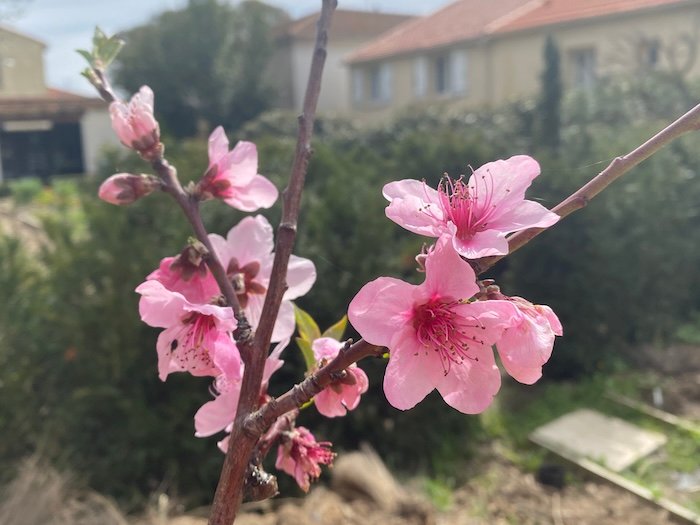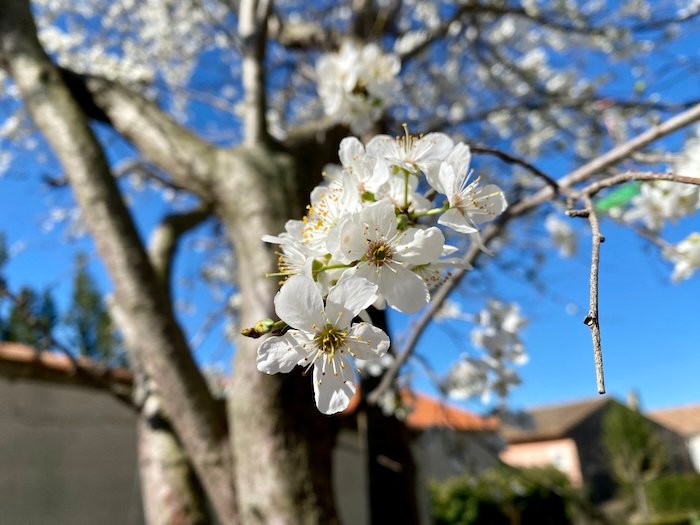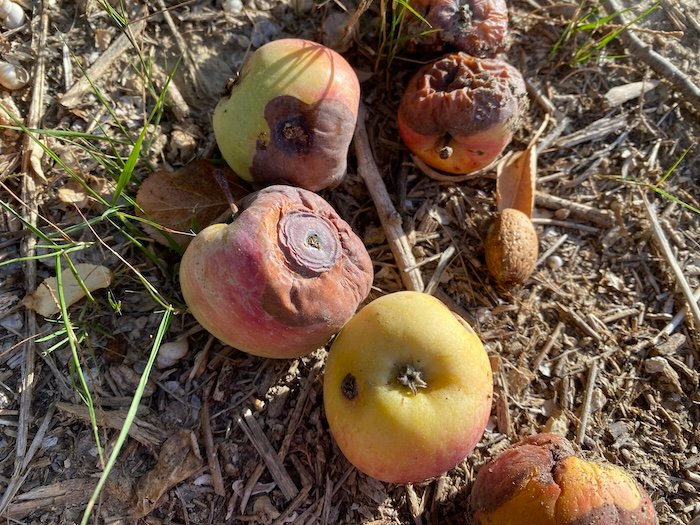This garden had been an orchard once upon a time. There was a cherry plum (prunus cerasiferus) that had created its own little forest, damaging the garden wall in the process. A big old fruit tree of unknown kind that was more or less dead on its legs. Two stunted old apple and pear trees, and a cherry tree trying to reach the sky. A hedge of tall figs, and a young abricot and peach tree of about 150cm each, that had been planted relatively recently.
The cherry plum (or what was left of it after trimming) was the first to bloom in March of 2023, creating a magnificently scented white cloud, very popular with everything that hummed. Toward the end of March the peach and abricot trees came out with gorgeous pink and white-pink flowers.
The apple tree bloomed abundantly in April, the pear tree much less, and the cherry tree almost not at all – probably because I had trimmed them all rather severely.
Sadly for some of them this was their last year of bloom.
Who Needs Cherry Plums?
The Myrobalane or “cherry plum” fruited abundantly but its raw fruit is not really enjoyable and needs to be made into jam. With ripening the flesh becomes softer and sweeter, but the skin becomes unpleasantly acidic and the stone is impossible to separate from the pulp. I did what I could but even so most of the fruit ended up on the gravel around the tree, creating a huge mess that even the wasps weren’t all that interested in.
Apparently this tree is very popular in Eastern Europe. Here it is planted mostly to aid in pollination among fruit trees. Since it was also leaning quite heavily across the plot chosen for the potager, we had it cut down in the fall.
Rotten Apples
The apple tree also fruited very well but by September every single apple was riddled with codling moth holes and/or monilia. And when a large fomitopsis fungus developed on its trunk in a matter of days it was clear that it was on its last legs and should be taken down as well.
The young peach tree had produced one wormy peach in 2022. In 2023 it showed heavy peach leaf curl, losing all of its leaves and flowers, and constantly bleeding during the summer. As I do not intend to garden by spraying chemicals several times a year, it had to go. When I took it out, its root ball was still the size of a plastic plant pot so had not really taken hold in the 2(?) years since its planting. The abricot produced two lovely sweet fruit in the summer, was carefully moved to a better location in the fall – and died in the winter.
The pear and cherry tree are both still doing okay and blooming nicely this spring. The figs fruited well last summer and I hope will again this year, after a thorough cleaning out from the ground up. They had been cut straight across the top, creating a forest of more or less naked 3-meter-stems with tassel-like tops.
New Additions
I added to the orchard as well. In 2022 I planted a dwarf morello cherry tree “Stella”, a dwarf fig tree “Ice Crystal”, a Japanese Silverberry bush (Elaganus umbellata amoroso), red and white currants, a gooseberry bush, raspberries, and thornless blackberries, a goji berry, as well as strawberries and a grapevine “Venus”. They all survived the last summer, naturally without producing much fruit in their first year after planting – except for the grape vine, which had three beautiful bunches of dark sweet grapes in its first year. In 2023 I added a Cornelian cherry (cornus mas) “Schönbrunner Gourmet Dirndl”, a plum tree “d’Agen”, tayberries, an autofertile kiwi, a white mulberry tree and two more grapevines, “Goldlife Muscat” and “Galanth”, that I want to grow in a goblet shape instead of along the back wall.
The goji berry has already been dug up and given away again to wreak havoc in other gardens. Gojis do work very well here, even without much water at all. But I have hardly ever seen a plant so bent on taking over the world. And since I’m not that crazy about the taste either I spent a few months digging up every last bit of root trying to grow into another sprawling bush. My advice: If you want to plant goji in your garden, invest in a good root barrier.












Leave a Reply